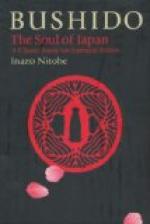“For fear lest clouds
may dim her light,
Should she but graze
this nether sphere,
The young moon poised
above the height
Doth hastily betake
to flight.”
[Footnote 25: For a very sensible explanation of nudity and bathing see Finck’s Lotos Time in Japan, pp. 286-297.]
It would be unfair to give my readers an idea that masculinity alone was our highest ideal for woman. Far from it! Accomplishments and the gentler graces of life were required of them. Music, dancing and literature were not neglected. Some of the finest verses in our literature were expressions of feminine sentiments; in fact, women played an important role in the history of Japanese belles lettres. Dancing was taught (I am speaking of samurai girls and not of geisha) only to smooth the angularity of their movements. Music was to regale the weary hours of their fathers and husbands; hence it was not for the technique, the art as such, that music was learned; for the ultimate object was purification of heart, since it was said that no harmony of sound is attainable without the player’s heart being in harmony with herself. Here again we see the same idea prevailing which we notice in the training of youths—that accomplishments were ever kept subservient to moral worth. Just enough of music and dancing to add grace and brightness to life, but never to foster vanity and extravagance. I sympathize with the Persian prince, who, when taken into a ball-room in London and asked to take part in the merriment, bluntly remarked that in his country they provided a particular set of girls to do that kind of business for them.




